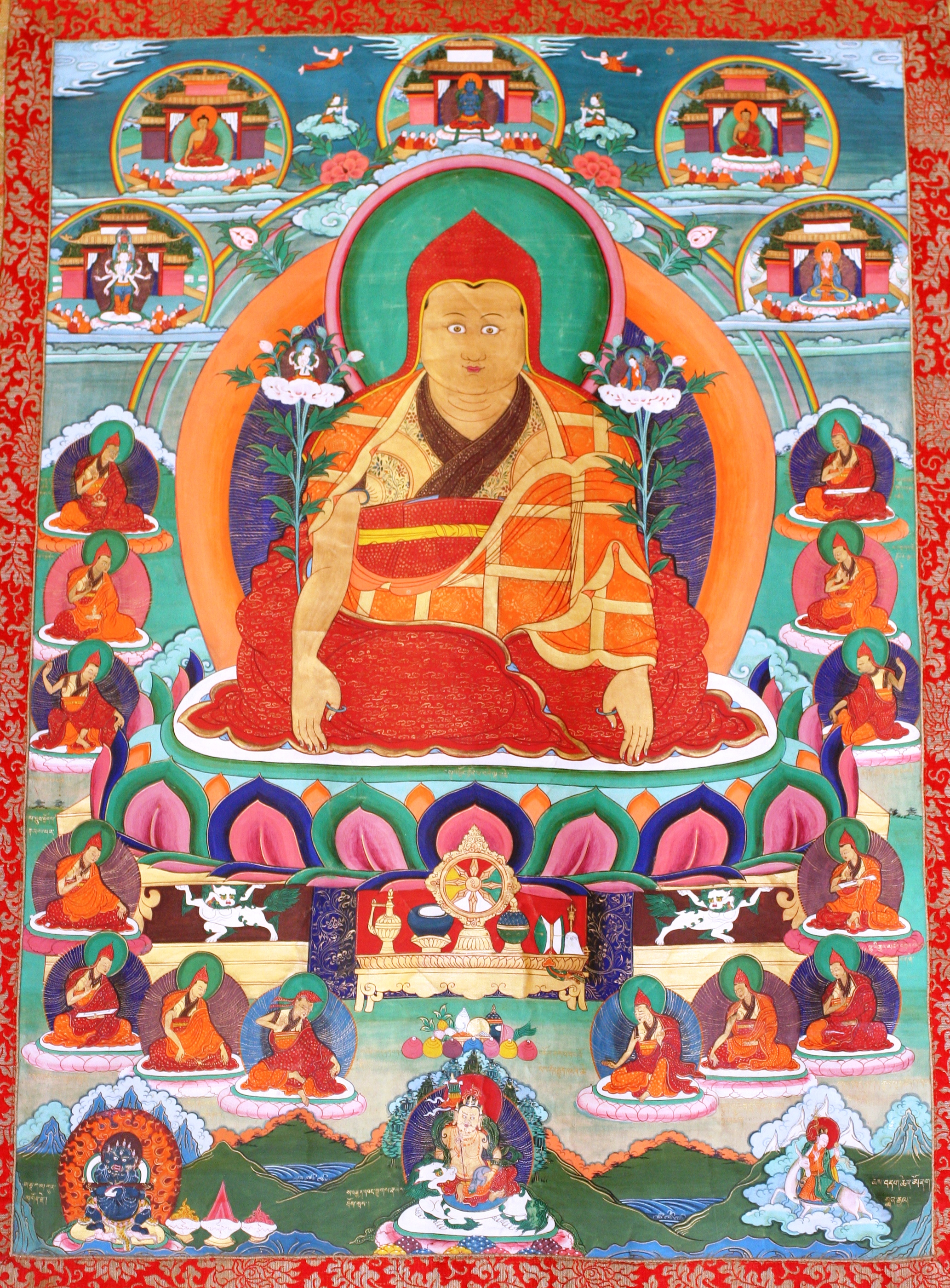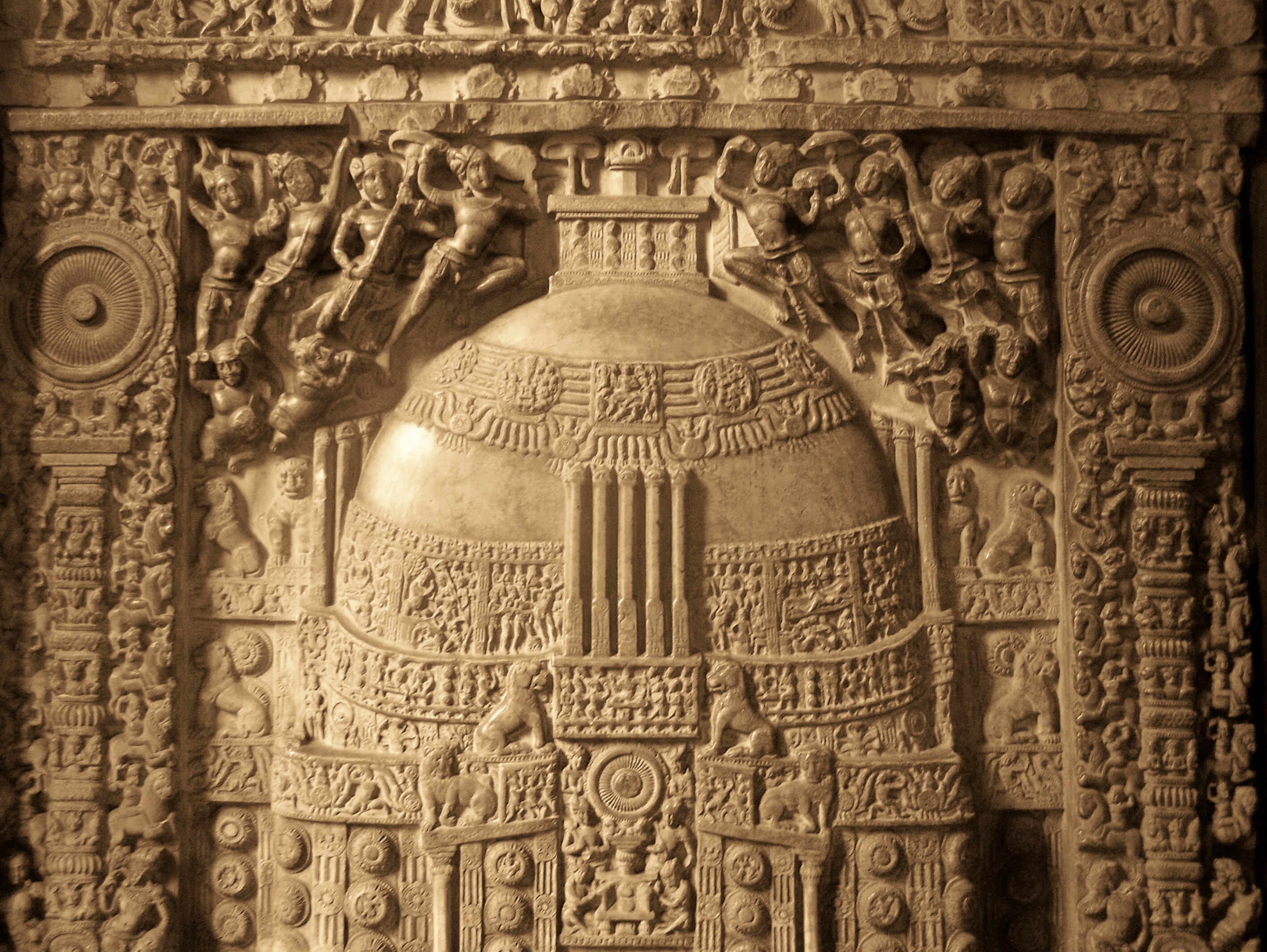|
Dolpopa Sherab Gyaltsen
Dölpopa Shérap Gyeltsen () (1292–1361),Newland (1992). p. 29 known simply as Dölpopa, was a Tibetan Buddhist master. Known as "The Buddha from Dölpo," a region in modern Nepal, he was the principal exponent of the shentong teachings, and an influential member of the Jonang tradition of Tibetan Buddhism. Biography Dölpopa was born in Dölpo. In 1309, when he was seventeen, he ran away from home to seek the Buddhist teachings, first in Mustang and then in Tibet. In 1314, when he was twenty-two years old, Dölpopa received full monastic ordination from the famous abbot of Choelung Monastery, Sönam Trakpa (1273–1352), and made a vow at the time to never eat slaughtered meat again. In 1321, Dölpopa visited Jonang Monastery at Jomonang (which was later destroyed during the Cultural Revolution) for the first time. He then visited Tsurphu Monastery for the first time and had extensive discussions with Rangjung Dorje, 3rd Karmapa Lama, about doctrinal issues. It appea ... [...More Info...] [...Related Items...] OR: [Wikipedia] [Google] [Baidu] |
Tibetan Script
The Tibetan script is a segmental writing system, or '' abugida'', forming a part of the Brahmic scripts, and used to write certain Tibetic languages, including Tibetan, Dzongkha, Sikkimese, Ladakhi, Jirel and Balti. Its exact origins are a subject of research but is traditionally considered to be developed by Thonmi Sambhota for King Songtsen Gampo. The printed form is called uchen script while the hand-written form used in everyday writing is called umê script. This writing system is especially used across the Himalayan Region. History Little is known about the exact origins of Tibetan script. According to Tibetan historiography, it was developed during the reign of King Songtsen Gampo by his minister Thonmi Sambhota, who was sent to India along with other scholars to study Buddhism along with Sanskrit and other brahmi languages. They developed the Tibetan script from the Gupta script while at the Pabonka Hermitage. This occurred , towards the beginning of ... [...More Info...] [...Related Items...] OR: [Wikipedia] [Google] [Baidu] |
Guru
Guru ( ; International Alphabet of Sanskrit Transliteration, IAST: ''guru'') is a Sanskrit term for a "mentor, guide, expert, or master" of certain knowledge or field. In pan-Indian religions, Indian traditions, a guru is more than a teacher: traditionally, the guru is a reverential figure to the disciple (or ''wikt:शिष्य, shisya'' in Sanskrit, literally ''seeker [of knowledge or truth'']) or student, with the guru serving as a "counsellor, who helps mould values, shares experiential knowledge as much as Knowledge#Hinduism, literal knowledge, an Role model, exemplar in life, an inspirational source and who helps in the spiritual evolution of a student". Whatever language it is written in, Judith Simmer-Brown says that a tantra, tantric spiritual text is often codified in an obscure twilight language so that it cannot be understood by anyone without the verbal explanation of a qualified teacher, the guru. A guru is also one's spiritual guide, who helps one to discover the ... [...More Info...] [...Related Items...] OR: [Wikipedia] [Google] [Baidu] |
Shenpen Hookham
Susan Kathryn Hookham (née Rowan), known as Lama Shenpen Hookham is a Buddhist teacher who has trained for over 50 years in the Mahamudra and Dzogchen traditions of Tibetan Buddhism. Biography Lama Shenpen was born Susan Kathryn Rowan in Essex, England, in 1946. She first encountered Buddhism while studying Geography and Sociology at Reading University, where she became secretary of the University Buddhist Society and had early encounters with Sangharakshita and Chögyam Trungpa Rinpoche. amongst others. In the early 1970s, on the advice of Chögyam Trungpa Rinpoche, Lama Shenpen went to India where she lived as a nun for six years, ordained by the 16th Karmapa. There she studied and meditated in retreat under the guidance of Tibetan teachers such as Karma Thinley Rinpoche, Bokar Rinpoche and Kalu Rinpoche. Rangjung Rigpe Dorje, the 16th Karmapa and head of the Kagyu tradition of Tibetan Buddhism, subsequently instructed her to return to the West to teach Mahamudra. She met h ... [...More Info...] [...Related Items...] OR: [Wikipedia] [Google] [Baidu] |
Kagyu
The ''Kagyu'' school, also transliterated as ''Kagyü'', or ''Kagyud'' (), which translates to "Oral Lineage" or "Whispered Transmission" school, is one of the main schools (''chos lugs'') of Tibetan Buddhism, Tibetan (or Himalayan) Buddhism. The Kagyu lineages trace themselves back to the 11th century Indian Mahasiddhas Naropa, Maitripa and the yogini Niguma, via their student Marpa Lotsawa (1012–1097), who brought their teachings to Tibet. Marpa's student Milarepa was also an influential poet and teacher. The Tibetan Kagyu tradition gave rise to a large number of independent sub-schools and lineages. The principal Kagyu lineages existing today as independent schools are those which stem from Milarepa's disciple, Gampopa (1079–1153), a monk who merged the Kagyu lineage with the Kadam (Tibetan Buddhism), Kadam tradition. The Kagyu schools which survive as independent institutions are mainly the Karma Kagyu, Drikung Kagyu, Drukpa Lineage and the Taklung Kagyu. The Karma Kag ... [...More Info...] [...Related Items...] OR: [Wikipedia] [Google] [Baidu] |
Nyingma
Nyingma (, ), also referred to as ''Ngangyur'' (, ), is the oldest of the four major schools of Tibetan Buddhism. The Nyingma school was founded by PadmasambhavaClaude Arpi, ''A Glimpse of the History of Tibet'', Dharamsala: Tibet Museum, 2013. as the first translations of Buddhist scriptures from Pali and Sanskrit into Tibetic languages, Tibetan occurred in the eighth century. The establishment of Tibetan Buddhism and the Nyingma tradition is collectively ascribed to Khenpo Shantarakshita, Guru Padmasambhava, and King Trisong Detsen, known as ''Khen Lop Chos Sum'' (The Three: Khenpo, Lopon, Chosgyal). The Nyingma tradition traces its Dzogchen lineage from the Adi-Buddha, first Buddha Samantabhadra to Garab Dorje, and its other lineages from Indian mahasiddhas such as Sri Singha and Jnanasutra. Yeshe Tsogyal recorded the teachings. Other great masters from the founding period include Vimalamitra, Vairotsana, and Buddhaguhya. The Nyingma tradition was physically founded at Samye ... [...More Info...] [...Related Items...] OR: [Wikipedia] [Google] [Baidu] |
Śrīmālādevī Siṃhanāda Sūtra
The ''Śrīmālādevī Siṃhanāda Sūtra'' (, '' of Queen Śrīmālā'') is one of the main early Mahāyāna Buddhist texts belonging to the Tathāgatagarbha sūtras that teaches the doctrines of Buddha-nature and "One Vehicle" through the words of the Indian queen Śrīmālā. After its composition, this text became the primary scriptural advocate in India for the universal potentiality of Buddhahood. History Brian Edward Brown, a specialist in Buddha-nature doctrines, writes that the composition of the ''Śrīmālādevī Siṃhanāda Sūtra'' occurred during the Īkṣvāku Dynasty in the 3rd century CE as a product of the Caitika schools of the Mahāsāṃghikas. Alex Wayman has outlined eleven points of complete agreement between the Mahāsāṃghikas and the ''Śrīmālā'', along with four major arguments for this association. Anthony Barber also associates the earlier development of the '' Tathāgatagarbha Sūtra'' with the Mahāsāṃghikas, and concludes that the M ... [...More Info...] [...Related Items...] OR: [Wikipedia] [Google] [Baidu] |
Aṅgulimālīya Sūtra
The ''Aṅgulimālīya Sūtra'' ( Taishō 120) is a Mahāyāna Buddhist scripture belonging to the Tathāgatagarbha class of sūtra, which teach that the Buddha is eternal, that the non-Self and emptiness teachings only apply to the worldly sphere and not to Nirvāṇa, and that the Tathāgatagarbha is real and immanent within all beings and all phenomena. The sutra consists mostly of stanzas in verse. The Mahāyāna ''Aṅgulimālīya Sūtra'' should not be confused with the Pāli Canon's '' Angulimala Sutta'', which is a completely different work included in the Majjhima Nikaya. Origins and history According to Stephen Hodge, internal textual evidence in the ''Aṅgulimālīya Sūtra'', ''Mahābherihāraka Parivarta Sūtra'', and the ''Mahāyāna Mahāparinirvāṇa Sūtra'', indicates that these texts were first circulated in southern India, and they then gradually propagated up to the northwest, with Kashmir being the other major center. The ''Aṅgulimālīya Sūtra'' g ... [...More Info...] [...Related Items...] OR: [Wikipedia] [Google] [Baidu] |
Mahāyāna Mahāparinirvāṇa Sūtra
The ''Mahāyāna Mahāparinirvāṇa Sūtra'' (Sanskrit; , ; Vietnamese: ''Kinh Đại Bát Niết Bàn'') or ''Nirvana Sutra'' for short, is an influential Mahayana, Mahāyāna Buddhist Sutra, scripture of the Buddha-nature class. The original title of the sutra was ''Mahāparinirvāṇamahāsūtra'' (''Great Scripture of the Great Perfect Nirvāṇa'') and the earliest version of the text was associated with the Mahāsāṃghika-Lokottaravāda school.Baums, StefanReview of Habata, ''Die zentralasiatischen Sanskrit‐Fragmente des Mahāparinirvāṇa‐mahāsūtra''. Indo‐Iranian Journal 58: 71–78./ref> The sutra was particularly important for the development of East Asian Buddhism. The ''Nirvana sutra'' uses the backdrop of the Buddha's Parinirvana, final nirvana to discuss the nature of the The Buddha, Buddha, who is described in this sutra as undying and eternal, without beginning or end. The text also discusses the associated doctrine of buddha-nature (Buddha-nature, tat ... [...More Info...] [...Related Items...] OR: [Wikipedia] [Google] [Baidu] |
Ātman (Buddhism)
Ātman (), attā or attan in Buddhism is the concept of self, and is found in Buddhist literature's discussion of the concept of non-self ('' Anatta''). Most Buddhist traditions and texts reject the premise of a permanent, unchanging ''atman'' (self, soul). 'Anatta, Encyclopædia Britannica (2013), Quote: "Anatta in Buddhism, the doctrine that there is in humans no permanent, underlying soul. The concept of anatta, or anatman, is a departure from the Hindu belief in atman (“the self”)."; '' Steven Collins (1994), Religion and Practical Reason (Editors: Frank Reynolds, David Tracy), State Univ of New York Press, , p. 64; Quote: "Central to Buddhist soteriology is the doctrine of not-self (Pali: anattā, Sanskrit: anātman, the opposed doctrine of ātman is central to Brahmanical thought). Put very briefly, this is the uddhistdoctrine that human beings have no soul, no self, no unchanging essence."; '' Dae-Sook Suh (1994), Korean Studies: New Pacific Currents, University of Ha ... [...More Info...] [...Related Items...] OR: [Wikipedia] [Google] [Baidu] |
Nature Of Mind (Buddhism) , the unity of awareness and emptiness in the Kagyu tradition of Gampopa
{{disambiguation ...
Nature of mind (Sanskrit: cittatā or citta-dharmatā; Tibetan: སེམས་ཉིད་, ''semnyi''; Wyl. ''sems nyid'') may refer to: * Dharmatā, also called suchness or thatness (Tathātā), the true nature of all things in Mahayana Buddhism *Svasaṃvedana, the self-reflexive nature of consciousness in Buddhism *Mahāmudrā Mahāmudrā (Sanskrit: महामुद्रा, , contraction of ) literally means "great seal" or "great imprint" and refers to the fact that "all phenomena inevitably are stamped by the fact of Prajnaparamita, wisdom and Śūnyatā, empti ... [...More Info...] [...Related Items...] OR: [Wikipedia] [Google] [Baidu] |
śūnyatā
''Śūnyatā'' ( ; ; ), translated most often as "emptiness", " vacuity", and sometimes "voidness", or "nothingness" is an Indian philosophical concept. In Buddhism, Jainism, Hinduism, and other Indian philosophical traditions, the concept has multiple meanings depending on its doctrinal context. It is either an ontological feature of reality, a meditative state, or a phenomenological analysis of experience. In Theravāda Buddhism, ' often refers to the non-self (Pāli: ', Sanskrit: ') nature of the five aggregates of experience and the six sense spheres. ' is also often used to refer to a meditative state or experience. In Mahāyāna Buddhism, ' refers to the tenet that "all things are empty of intrinsic existence and nature ('' svabhava'')", but may also refer to the Buddha-nature teachings and primordial or empty awareness, as in Dzogchen, Shentong, or Chan. Etymology ''Śūnyatā'' is usually translated as "devoidness", "emptiness", "hollow", "hollowness", "v ... [...More Info...] [...Related Items...] OR: [Wikipedia] [Google] [Baidu] |
Kalachakra
''Kālacakra'' () is a Polysemy, polysemic term in Vajrayana, Vajrayana Buddhism and Hinduism that means "wheel of time" or "time cycles". "''Kālacakra''" is also the name of a series of Buddhist texts and a major practice lineage in History of Buddhism in India, Indian Buddhism and Tibetan Buddhism. The tantra is considered to belong to the unexcelled yoga (''Anuttarayoga Tantra, anuttara-yoga'') class. Kālacakra also refers both to a patron Tantra, tantric deity or yidam in Vajrayana and to the philosophies and yogas of the Kālacakra tradition. The tradition's origins are in India and its most active later history and presence has been in Tibet. The tradition contains teachings on cosmology, theology, philosophy, sociology, soteriology, myth, prophecy, Ayurveda, medicine and yoga. It depicts a mythic reality whereby cosmic and socio-historical events correspond to processes in the bodies of individuals. These teachings are meant to lead to a transformation of one's body and ... [...More Info...] [...Related Items...] OR: [Wikipedia] [Google] [Baidu] |






